Menu
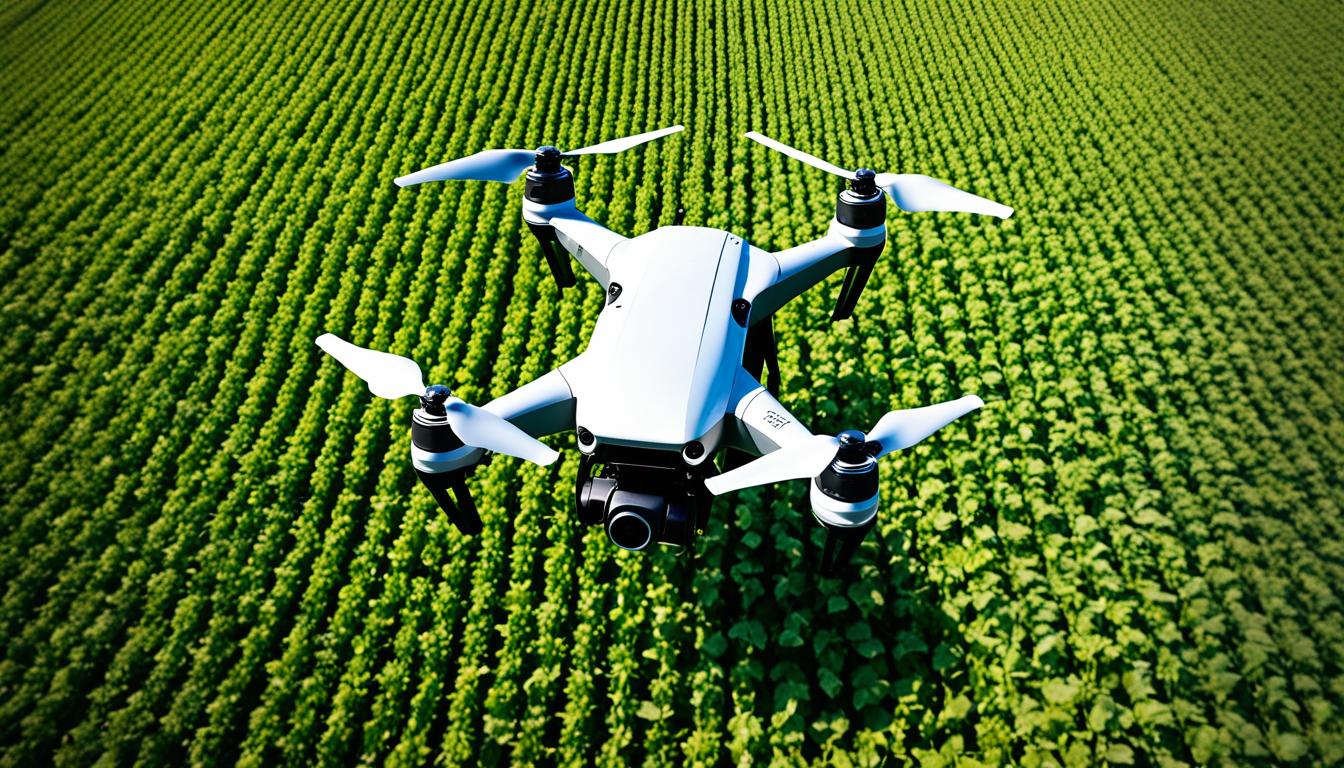
The market for agriculture drones is set to jump to $18.22 billion by 2030. This shows how important drone crop monitoring has become. In places like India, drones like the DJI Inspire 2 are changing farming for the better.
Using drones for crop monitoring finds problems early and helps farmers act quickly. They use smart technology to work more precisely, which means farmers use less but do better. This makes their farms more profitable and sustainable, improving both crops and profits.
Drone crop monitoring is changing how farming is done, thanks to flying unstaffed vehicles (UAVs) with high-tech sensors. These gadgets collect current data on the crop’s health, water needs, and the ground. This helps farmers in making smart choices. Using drones in farming can make managing resources better. This lowers waste while increasing food production. As drone tech gets better, it plays a bigger role in running farms well.
Drone crop monitoring uses flying robots with the latest sensors to get detailed and current information from the fields. These sensors, like RGB and multispectral cameras, look at the plants’ health and how wet the ground is. This info means farmers can react quickly and correctly, making their work better. The market for these farm drones was worth $4.17 billion in 2022. Experts think it will grow to $18.22 billion by 2030, showing a big increase every year.
Drone monitoring is crucial in farming today. It keeps a close and constant eye on big areas of land, finding issues early like sick crops or not enough water. Flying over hard-to-reach places is a big plus, like steep tea fields. For example, precision farming and drones together have increased crop levels by up to 5%. Drones can fly over up to 500 acres in a day. This saves a lot of time compared to old-fashioned methods.
Drone monitoring changes farming in a big way, providing huge amounts of very accurate information. This lets farmers be more sustainable and careful with their resources. With improvements in tech, like tiny drones for pollination and better ways to check the soil health, drones have a bright future in farming.
In the last ten years, agricultural drones have advanced quickly. They have changed farming from hard work to smart, automated methods. In India, the government leads this change. They use 100 “Kisan Drones” to spray pesticides and support making drones locally through schemes like PLI.
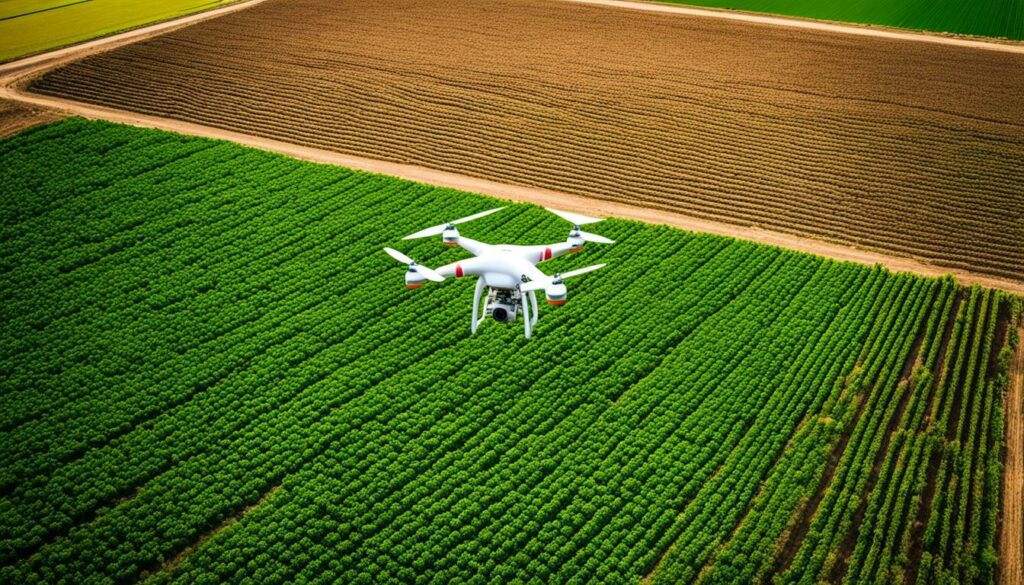
The story of agricultural drones starts with simple models used for taking pictures from the sky. But thanks to better tech and government backing, they evolved fast. Now, drones are used in farming tasks like checking on crop health from above and finding where crops need more water.
Today’s drones are packed with special sensors for better farm scanning. They can spot diseases on crops closely. Plus, they use AI and learning algorithms, making farm work more effective and cheaper for farmers. mPower makes durable batteries that keep drones in the air longer, which is great for farming.
| Innovation | Benefits |
|---|---|
| Advanced Sensors | High-resolution imagery, precise crop disease detection |
| AI and Machine Learning | Intelligent operations, low operational costs |
| Increased Payloads | Reduced operational time, cost efficiency |
| Thermal Cameras | Early detection of crop stress and disease |
Thermal cameras are improving how we look after crops. They give clear pictures of crop problems like disease or lack of nutrients. Using GPS and special software for mapping, farmers can make smarter decisions about water, fertiliser, and pest control. This means they can use resources better and grow more crops. Drones are changing how we fight pests and plant diseases. They also help save water and support farming without harming the environment.
The use of UAVs in farming is changing how we grow food. It brings new benefits and ways to do things better. With aerial maps and special sensors, farmers can check on their crops from above. This helps them to grow healthier crops, waste less, and protect the environment.
UAV monitoring is a big plus for farming. Here are a few key advantages:
UAV monitoring is not just for checking crops. It has many uses in farming:
| Application | Details |
|---|---|
| Soil Analysis | Drones look at soil and suggest the best water, fertiliser, and pesticide use. This wastes less and saves money. |
| Pesticide Spraying | In Brazil, using drones lowered pesticide use. They apply pesticides more directly, saving money and the environment. |
| Crop Health Monitoring | Thermal cameras monitor plant temperatures. They help save water and boost crop production. |
| Mechanical Pollination | UAVs might help pollinate as bees decrease. This could keep our ecosystems strong. |
As drones improve, so do the ways we use them in farming. Soon, they could fly by themselves and use smart technology. This will make UAVs even more important in growing food better.
Aerial crop mapping has changed farming, giving farmers precise and detailed views of their land. Drones collect data that lets farmers see the shape of their fields. This helps them plant better and manage their field resources wisely. It’s a big step in improving how farms are run. This helps make growing crops more successful.
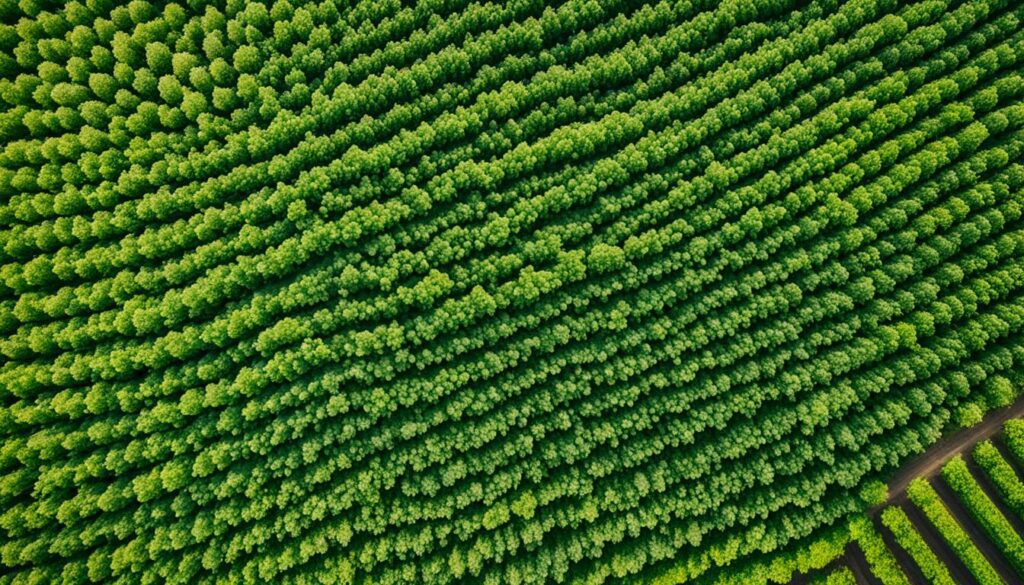
This new way of farming has a big financial impact. In India, it added up to about 19.48 lakh crore (US$ 276.37 billion) for agriculture, forestry, and fishing in one year. The area’s farming and related businesses grew by 4% in the same year. These numbers show how using aerial crop mapping can help farmers work better and make more money.
Drones can be very accurate when studying crops, up to 97%. This means fields can be looked at and planned better and faster. And because things are so precise, farmers do not have to use as much seed, fertiliser, or fuel. This saves money and helps the planet. Using drones this way, farmers can grow better crops using fewer resources.
The drones from Equinox show just how good aerial crop mapping can be. They have looked at over 4000 hectares of mining areas with 97% accuracy. This means they know what’s happening in fields in detail. They have also helped improve the accuracy of looking at 2500 acres of crops by 10%. Plus, they checked 2000 kms of railway making at triple the usual speed. This super-accurate information helps farmers decide how to best look after their crops.
“Using drone technology in farming wants to save resources while making crops better,” said someone who knows a lot about this.
In short, aerial crop mapping is crucial for today’s farming. It uses drones to gather data, helping farmers do their job better. This mix of technology and farming not only makes farms more efficient but also more profitable and kind to the environment.
Remote sensing techniques are changing how farms are run, giving detailed views of crops, soil, and the environment. This includes using RGB, multispectral, and thermal cameras. These methods collect data for smart decisions, improving the farm’s productivity and green practices.
Various methods are now used in farming. Drones with special sensors fly over large areas to take clear photos. This is key for checking soil, finding plant issues, and tracking water. Drones bring fast, easy data collection, skipping the old, hard ways of surveying.
Remote sensing is changing how farms are managed. Now, drones help farmers fine-tune irrigation, beat pests, and get better harvests. This tech lets farmers watch their fields from a distance, making smart choices to save resources and run things better.
The add of AI tech to drones makes jobs like crop spraying automated. This makes managing farms smoother. Special tools like Solvi for row crops and Aerobotics for bushes help farmers understand their aerial data better, cutting costs and improving harvests.
The coming together of these new techs is a big deal for farming. It boosts how precise and efficient farms can get. This leads to more crops, less harm to the planet, and farming in a way that keeps on working for everyone.
Advanced sensors are changing how we look after crops in farming. They use tech like multispectral and thermal sensors. With these sensors, agricultural drones get detailed data that we can’t see ourselves. This data helps farmers check on plant health, where water goes, and how crops are doing. It’s all about getting clear and accurate information.
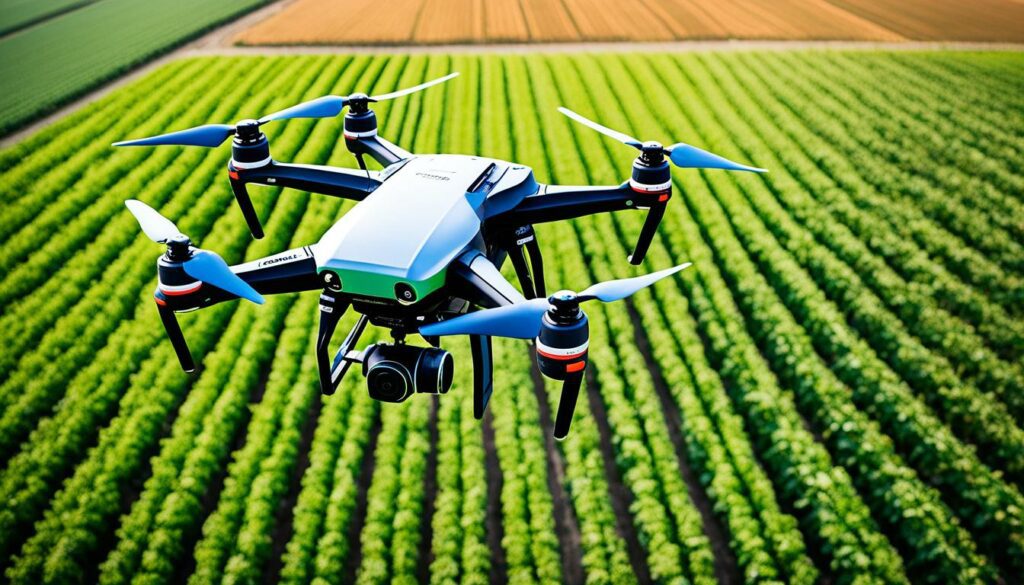
Multispectral sensors give us special images of fields in different colours. They help pinpoint issues like not enough nutrients or pests. Thermal sensors look at the heat plants give off. This shows if they need more water. Together, these tools are really helpful. They let farmers manage fields better.
These tools allow for quick data checks, which is a big deal. Drones with these sensors collect data fast. This means farmers can make quick choices. For example, they could use less fertiliser and insect spray. This helps save money and is good for the Earth. The quick checks also mean farmers can improve how they look after their crops right when they need to. This makes things better for growing crops.
These new ways of using data right away are changing agriculture. They make farming more accurate and eco-friendly. Good for the land and for growing food.
Unmanned aerial vehicles (UAVs), known as drones, provide high-resolution imagery and near real-time data for crop health, irrigation requirements, and farm management.
Using drones for soil analysis has changed farming. Now, farmers can check the quality and nutrients in their soil like never before. This helps them grow better crops and use their land more efficiently.
Drones with special sensors can check up to 500 acres every day. This is much faster than before, saving farmers a lot of time. Plus, it means they might use less fertiliser and pesticides, which is good for the environment.
With drones, farmers can see soil details clearly from the sky. These clear images help them decide what their fields need. For example, JOUAV drones can fly for a long time, checking the soil well over many hours. This makes managing the land better.
Using drones for soil checks makes crops healthier and lets farmers grow more. They can spot problems early, like not enough nutrients, and fix them quickly. This can cut down on harmful chemicals.
With drones, farmers can keep their fields in top condition. They can make sure there’s enough nitrogen, water, and fertiliser. This stops problems and means more crops, without damaging the environment.
Drone data collection is changing agriculture for the better. It offers many benefits, like predicting yields and monitoring crop health. The advanced techniques it uses gather a lot of information from fields. This makes the analysis part very important for making smart farming decisions.
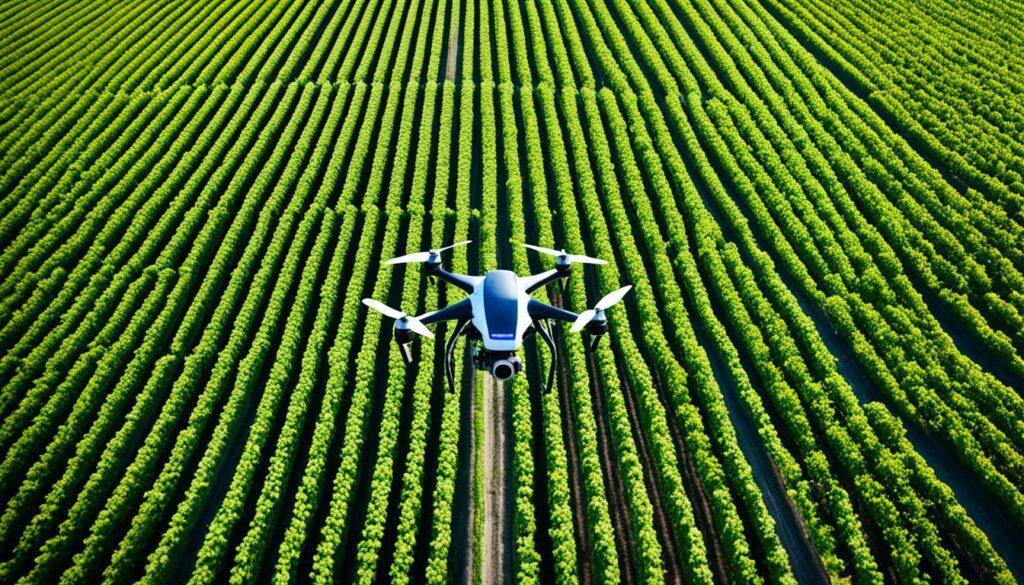
Creating 2D orthomosaics and digital surface models gives us in-depth looks at farms. Adding advanced sensors, like hyperspectral cameras, makes data analysis better. This means farmers can make more accurate decisions.
“56% of respondents in a DroneDeploy survey indicated that interpreting drone data to make crop decisions is the primary challenge in agriculture.”
Analysing drone data lets farmers turn raw info into smart actions. By using machine learning and AI, they can improve their returns. This happens when they connect the data with their farm systems. Such analysis helps in many ways, like checking on storm damage and keeping an eye on the livestock.
| Function | Benefits |
|---|---|
| Water Condition Assessment | Optimises irrigation and drainage management |
| Plant Stress Detection | Enables timely interventions |
| Crop Health Inventory | Provides data on population, size, and health |
| Seasonal Yield Prediction | Improves harvest planning and profitability |
Using drone data and then analysing it makes farming smarter. It helps farmers make decisions based on solid insights. This move the agriculture sector towards more sustainable and efficient practices.
Agricultural drones are changing how we spray pesticides with great accuracy and efficiency. They make use of digital farming to apply pesticides more wisely. This way, farms work better and more effectively.
Drones can cover up to 500 acres a day, saving farms a lot of time. They are much faster than the old methods. Drones apply pesticides according to the exact needs of each area, which can lower pesticide use by 30%.
They use sensors to adjust the amount of spray, so only what’s necessary is used. This saves money for the farmers and is better for the environment.
Drones like the JOUAV can carry up to 8kg and fly for up to 480 minutes. They work dependably for long periods. Fixed-wing drones are great at covering big areas. Multirotor drones are best for getting close and checking things out.
Pesticide drones help the environment by being precise. They fly in patterns that make sure the whole area gets treated evenly. This reduces the waste of pesticides and their harm to nature.
By targeting only the problem areas, drones cut down on the chemicals used. This smart method keeps the farm healthy without damaging the environment. It’s a win for everyone.
They also make the farm safer for people by not needing someone to spray by hand. This cuts the risk of people getting sick from handling chemicals. Drones can go where it’s hard for people to reach, treating every part of the farm.
Drones fight off pests quickly because they can reach far and wide fast. They protect crops better than slow-moving tractors. By acting early, they can save up to one-fourth more crops. Their data can also warn about diseases, helping the harvests grow.”円
| Feature | Benefit |
|---|---|
| Drones cover up to 500 acres per day | Up to 90% time saving compared to traditional methods |
| Precision data analytics | Reduces pesticide use by up to 30% |
| GPS-guided and automated flight plans | Minimises pesticide waste, benefits the environment |
| Spot spraying capability | Reduces chemical usage by 35%, conserving resources |
| Early disease detection | Potential increase in crop yields by 25% |
Field surveillance technology and crop health monitoring are key in today’s farming. Agriculture, forestry, and fishing added 19.48 lakh crore (US$ 276.37 billion) to the economy in FY20(PE). It’s important to use advanced tech to boost productivity and quality. The 4% GVA growth in these sectors shows the need for ongoing innovation.

Farmers who use drones for real-time crop health data gain an advantage. Drones with special cameras can spot crop problems from the start. This gives farmers a chance to act early. The data they collect is almost always correct, meaning farmers can predict crop success with 97% accuracy. This tech also helps study soil moisture, showing where crops might need more or less water.
Drones aren’t just for checking crops; they also help deal with crop problems fast. They can show damage from floods, fires, and pests. This quick look can save crops in time. Studies show using drones can mean less seed, fertiliser, and pesticide. And farmers may work less too.
| Key Benefits | Statistics |
|---|---|
| Growth in GVA | 4% in FY20 |
| Accuracy of Crop Predictions | 97% |
| Market Growth of Agricultural Drones | $1.2 billion in 2019 to $4.8 billion in 2024 |
| Increase in Yields via Precision Farming | Up to 5% |
| Drone Seeding Efficiency | 400,000 trees/day |
The use of drones is growing fast. Experts say their market will go from $1.2 billion in 2019 to $4.8 billion by 2024. Drones are a big part of making farming more precise. They can boost crop yields by up to 5%. Amazingly, with drone seeders, it’s possible to plant 400,000 trees daily. This shows the huge potential of these technologies.
South Korea is a great example of using drones well. They use drones for about 30% of their crop spraying. These drones do a fine job, using less chemicals more carefully. While drone rules vary worldwide, work is ongoing to improve how they work.
The use of drones is growing broadly. From checking soil health with microwaves in Australia to helping small farms worldwide, more farmers are getting access. This tech is on the rise. It promises to boost farming success and care for the environment more than ever before.
Using drones to monitor crops has brought huge benefits to farming. It has shown that drone technology can greatly change farming for the better. But, it also points out some key areas that need work.
Many studies show how drone crop monitoring has improved farm productivity. For example, farmers found up to a 5% increase in their crops when using drones. This is quite big as farming usually has small profits.
Drones can check 500 acres a day, saving loads of time compared to traditional methods. They have also been key in spotting diseases early, increasing crops by 25% and cutting down the need for chemicals by 35%.
In both Australia and South Korea, drones have made a real impact. South Korea uses drones for about 30% of spraying jobs. This shows a clever way to spray pesticides that’s kinder to the environment.
Even though drones help a lot, there are still challenges. These include high starting costs and the need for special training. Connecting drones with farm systems can also be hard.
The answer is to keep improving and offering support. New AI and machine learning tech are making drone data analysis better. Making drones fit specific farm needs and offering good support and training can help a lot. Also, making sure rules and setups are the same everywhere will make drones on farms easier.
When you’re looking at selecting agricultural drones, it’s important to think about a few key points. The right drone can do wonders for supervising crops, creating maps, and improving farm work.
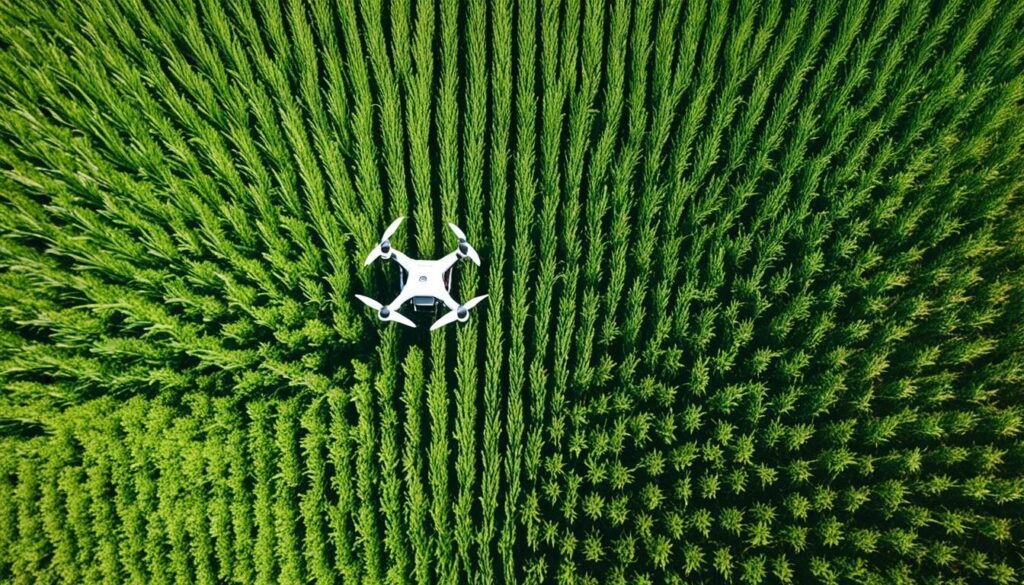
Picking the right drone for farming means considering some important things:
Knowing the differences between drone models makes selecting the right one easier. Let’s compare some of the top drones in precision farming:
| Drone Model | Flight Time | Sensors | Highlights |
|---|---|---|---|
| DJI Mavic 3 Multispectral | 45 minutes | Multispectral, RGB | Four 5MP multispectral cameras, accurate NDVI results, ideal for orchard mapping |
| DJI Matrice 350 RTK | 55 minutes | Thermal, RGB, RTK | Enhanced precision with RTK, compatible with MicaSense payloads for intricate irrigation detail |
| JOUAV CW-15 | 480 minutes | Hyperspectral, Laser point cloud | Superior efficiency, covers large areas, enhanced crop monitoring efficiency |
| DSLRPros EVO II 640T | 40 minutes | Thermal, Visual | 8K video, 4x lossless zoom, perfect for livestock management |
The DJI Mavic 3 Multispectral and JOUAV CW-15 are fantastic examples of advanced drones. They boost efficiency and accuracy with their top-notch sensors and long flight times. This allows them to cover vast fields and analyse in great detail. They help make the best use of farming resources and increase crop production.
In the end, picking the right drone means matching its abilities to what your farm needs. It’s about using various technologies to offer the best in precision farming.
The future of precision farming is looking bright with the rise of agricultural drones. These drones are getting more advanced, with high-tech sensors and AI that can interpret data. This means we’re about to see big changes in how farms are run.
The market for agriculture drones is growing rapidly. It was worth $4.17 billion in 2022 but is expected to hit $18.22 billion by 2030. This means more and more farmers are relying on drone tech for their work.
Drones can cover a massive area of farmland in just one day, saving up to 90% of the time it would usually take. Not only that, they can increase crop yields by up to 5%. This helps farmers make better choices and be more productive.
There are also big environmental benefits to using drones. By spotting diseases early, they can boost crop yields by 25%. This might cut down on the need for fertilizers and pesticides by 30%. It’s a win for the planet, reducing pollution by 35% thanks to less chemical use.
| Benefit | Impact |
|---|---|
| Increased Yield | Up to 5% boost |
| Time Savings | 90% reduction in time |
| Fertilizer and Pesticide Reduction | Up to 30% less usage |
| Pollution Reduction | 35% decrease |
Take the JOUAV drones, for example. They can carry up to 8kg and fly for 480 minutes, making farm work more efficient. With a sharp, full-colour view from 60m up, they’re great for studying plants. This kind of tech is key for the future of farming.
These trends suggest agriculture is on the brink of a big change, thanks to drones. They’ll improve how farms are managed, saving money and helping the environment. Drones are becoming essential in making farming more precise and efficient.
Drone technology is transforming farming by offering better precision and efficiency. Drones with thermal cameras spot crop issues early, like stress or disease. This lets farmers act fast.
Using GPS and special software, drones can map fields precisely. This helps farmers make smart choices on water, fertilisers, and fighting pests. Efficient use of resources boosts the harvest and cuts waste.
Farming is changing a lot with drones. They save time and money, checking crops over large areas fast. They work for any farm size, giving easy ways to use the data for better decisions.
The use of drones in farming is growing fast, with the market set to soar from $1.2 billion in 2019 to $4.8 billion by 2024. Drones could increase harvests by 5%. Those who adopt early see healthier crops and savings, pushing others to follow. This marks a big step in farming, making it more sustainable and profitable.
Drone crop monitoring uses aerial drones with special sensors to check on crops. They gather lots of data quickly about crop health, water needs, and soil quality. This helps farmers make smart choices about how to look after their crops better, saving resources and getting bigger harvests.
It’s very important, especially in places like India. Drones, such as the DJI Inspire 2, fly above farms and can spot problems early. This early warning helps farmers act fast to protect their crops, increasing their chances of a good harvest.
Agricultural drones now have special cameras and sensors for better pictures and data. They can see things like crop health and stress, which helps with planning irrigation and checking for damage. This tech has made it easier for farmers to manage their fields.
UAV monitoring means farmers can see their crops in great detail and very often. This tech speed things up and means less work by hand. It also helps with understanding the soil, spraying pesticides, keeping count of crops, and watching how they grow. This saves a lot of time and effort.
Mapping from above gives farmers detailed views of their fields. It includes landscape details that help with planting and managing resources better. Farm management has improved with these focused actions, increasing productivity and keeping crops healthy.
Today, agriculture uses special cameras for pictures and thermal scanners to sense heat. This technology tells farmers how well their crops are, how much water they have, and what the soil is like. It’s key for keeping crops and fields in good shape.
These sensors see more than just what we see with our eyes, showing the health of plants, where water goes, and if crops are stressed. This detailed info helps farmers treat their crops the best way, improving how they manage and grow their fields.
Drones make soil checks quick and detailed, showing its health and what it needs. With this info, farmers can plan better for their soil and their plants, leading to healthier and better-producing crops.
By collecting lots of field data, drones help make very accurate predictions. This info about yields, when crops start growing, and if they’re damaged is crucial for farming decisions. It makes farming smarter and more scientific.
Drones make it possible to spray pesticides only where they are needed, using less. This saves money, protects the environment, and keeps farmers safer. It’s a big step forward in farming safely and sustainably.
Drones give farmers a bird’s-eye view, spotting problems before they spread. They use high-quality images to catch any issues early, helping to keep the crops healthy and the yields safe.
Yes, studies show drones can really make a difference, improving both efficiency and the amount of crops grown. Despite the challenges of cost and technical know-how, farmers find solutions to make drone tech work for them. This keeps farming moving forward with better methods.
Consider how long a drone can fly, how much it can carry, the quality of its sensors, and its processing power. The DJI Mavic 3 Multispectral and DJI Matrice 350 RTK are known for being precise and top-notch for farming.
The future will bring more drones that can do things on their own, understand data with AI, and be used in more types of farms. These changes will make precision farming even more efficient and productive.